
For those who’re searching for a significant-efficiency
Why Photo voltaic Panel Cleaning Matters
Photo voltaic panels seize Strength at their greatest when thoroughly clean. Dust, pollen, bird droppings, and smog reduce performance—occasionally by twenty% or even more. Typical cleansing can help keep optimum overall performance, increase panel lifetime, and safeguard your expense.
Most important Added benefits:
- Improved Electricity output
- Reduced electricity expenses
- Extended panel lifespan
- Diminished threat of micro‑cracks as a result of thermal hotspots
Forms of Solar Cleansing Resources
Choosing the suitable Instrument depends on your set up, water availability, and preferred comfort. Types involve:
- H2o‑powered solar brush devices
- Moveable photo voltaic panel cleaning package bundles
- Pure drinking water cleansing programs
- Rotary photo voltaic brushes and extension poles
H2o Powered Solar Brush Programs
These brushes hook up with a h2o supply and spin while dispensing h2o, combining cleaning and lubrication in one step. The result: spotless panels without the need of scratching.
Critical Functions:
- Built-in water feed from the brush head
- Gentle bristles Risk-free for glass surfaces
- Rotary movement lowers manual energy
- Mounts on extension poles for rooftop accessibility
Moveable Solar Panel Cleansing Package
A whole
- Brush head (fastened or rotating)
- Extension pole (adjustable lengths approximately 6 m)
- Hose adapters or fast‑link fittings
- Pure‑h2o tank or filtration system
- Gentle microfiber towels or squeegees
- Non‑abrasive cleaning Alternative (if permitted)
Benefits of All-in-A single Kits:
- Begin cleansing with minimum set up
- Compact for storage or journey
- Suitable with household or industrial photo voltaic arrays
Pure Drinking water Solar Cleaning Units
These units purify neighborhood h2o—getting rid of minerals and Filth—so it gained’t go away scale or streaks. Pure h2o empowers Qualified-quality success with no substances.
How It Works:
- Pretreatment filtration (sediment, carbon, ion exchange)
- Closing deionization or reverse‑osmosis phase
- Filtered drinking water circulated as a result of brush for cleansing
- Residue‑free drying—no places or streaks left at the rear of
Rotary Photo voltaic Brush & Extension Poles
For big photo voltaic arrays or industrial use, an influence-rotating head with a telescoping extension pole would make cleaning successful and Protected.
Pros:
- Considerably less physical hard work, quicker protection
- Reach roofs and ground‑mounted panels conveniently
- Adjustable shaft lengths for varying angles
- Universal brief‑connect methods for accessories
Give attention to Safety & Very best Procedures
Cleansing photo voltaic panels entails heights and slippery surfaces—security to start with:
- Use non‑conductive extension poles
- Steer clear of strain washers which can crack glass
- Function early or late in order to avoid glare and warmth
- Don grips and slip-resistant sneakers
- Notice local water‑use guidelines or limitations
Phase‑by‑Action Cleaning Regime
- Change off the solar inverter or make certain technique is deactivated
- Rinse panels with very low‑tension h2o
- Utilize a brush (or photo voltaic brush kit) with drinking water feed
- Scrub gently in overlapping, linear passes
- Rinse completely with thoroughly clean water
- Dry with microfiber squeegee or gentle towel—only if needed
Deciding on the Ideal Solar Panel Cleansing Resource
Take into consideration your set up along with your water access:
Maintenance & Treatment Tips
- Flush hose and brush immediately after Each and every use
- Retail outlet dry, thoroughly clean, and faraway from UV publicity
- Substitute worn brush heads—and Look at bristle softness
- Inspect seals and connectors for leaks
- Change or cleanse filters in pure‑h2o methods routinely
Eco-Helpful Cleansing Benefits
Appropriate cleansing prolongs photo voltaic panel performance and minimizes Vitality squander. Applying h2o by yourself—without the need of soaps or chemicals—aids protect regional ecology and avoids runoff pollution.
How Solar Panel Cleaning Impacts ROI
Sensible servicing applying quality brushes and kits keeps method efficiency topped up, lowering the payback time period and maximizing Vitality produce after a while.
Value Things to consider & Price
- Drinking water‑driven solar brushes are cost-powerful and durable
- Pure water systems involve upfront investment but offer consistent, location‑absolutely free cleaning
- Rotary brush kits Increase efficiency—worthwhile for large installations
- DIY kits help you save labor expenditures; Specialist providers Price more but unlock your time and efforts
Typical Uses of Photo voltaic Panel Brushes
- Residential rooftops
- Professional solar farms
- RV or cell installations
- Solar carports
- BIPV segments (constructing‑integrated photovoltaics)
Purchaser Testimonials & Use Conditions
“This solar panel cleansing brush produced a apparent big difference in just minutes—dust absent, no streaks, and our output enhanced!”
“Upgrading to some drinking water‑run solar brush saved hrs of scrubbing. Coupled with a pure water process, the panels looked fresh.”
FAQs About Photo voltaic Panel Cleansing
How often really should panels be cleaned?
Each 6 to twelve months, dependant upon your weather—much more generally in dusty or pollen-heavy areas.
Can rain cleanse photo voltaic panels?
Rain helps but doesn’t eradicate Filth buildup or movie levels—handbook cleaning yields far better effectiveness.
Am i able to use faucet h2o?
Faucet h2o might leave mineral residue. A
Can cleansing damage panels?
Provided that abrasive tools or substantial-force washers are made use of. Normally use soft bristles, reduced-stress, and adhere to manufacturer recommendations.
Pro Strategies for Solar Panel Homeowners
- Cleanse early early morning or evening to prevent thermal tension
- Keep track of output information—if overall performance drops, clean panels
- Keep panels angled—standing h2o promotes algae development if left much too very long
- Rotate brush heads periodically to keep up even dress in
Summary: A Brush For each Require
Regardless of whether you’re looking for a cost-powerful
Discover the total pure water solar cleaning line of brushes and extras intended especially for solar cleansing at